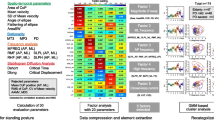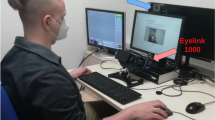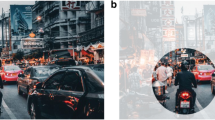Abstract
We recorded the sagittal and frontal components of the stabilogram of healthy humans in upright undisturbed stance under five conditions of visual control: (i) open eyes (OE); (ii) closed eyes (CE); (iii) visual inversion (VI); (iv) central vision (CV), and (v) diffused light (DL). Through a low-pass filter of trajectories of the center of pressure of feet (CPF), the vertical projection of the center of gravity (CG) and, consequently, the difference CPF-CG were estimated. The former represents the controlled variable, while the latter is proportional to the horizontal acceleration and assumed to express the resultant joint stiffness (mostly in the ankle joints). The stiffness was characterized through a method based on spectral analysis of the CPF-CG variable and subsequent calculations of the median frequency (MF) and the root mean square (RMS) of the spectra. The median frequencies of the spectra of the CPF-CG variable changed slightly under various visual conditions. At standing on a rigid support, they varied from 0.97 to 0.99 Hz and from 0.93 to 0.97 Hz for the CPF-CG, calculated from the sagittal and frontal components of the stabilogram, respectively. Under conditions of a pliable support, the corresponding frequencies varied within the limits of 0.79–0.83 Hz and 0.74–0.78 Hz. In contrast to the median frequencies, the RMSs demonstrated greater variability depending on different visual conditions. At standing on a rigid support, paired comparisons showed significant differences between the RMSs of the spectra of the CPF-CG variable of the sagittal direction under CE and OE conditions (0.14 ± 0.030 and 0.09 ± 0.020 mm, respectively) and under DL and OE conditions (0.130 ± ± 0.025 and 0.090 ± 0.020 mm, respectively). The RMS of the CPF-CG variable calculated for the frontal stabilogram differed significantly from each other for the VI and OE conditions (0.115 ± 0.020 and 0.075 ± ± 0.015 mm, respectively). In case of standing on a pliable support, a greater variability of visual influences on the CPF-CG variable was found. The RMS for its sagittal motion was the greatest under CE conditions (0.19 ± 0.03 mm); it was significantly greater than the respective values under OE, CV, and DL conditions (0.097 ± ± 0.020, 0.110 ± 0.020, and 0.140 ± 0.030 mm, respectively). The means of RMSs of the spectra of the frontal CPF-CG was also the greatest under CE conditions (0.20 ± 0.03 mm) and the smallest under OE conditions (0.095 ± 0.020 mm). In addition, the value of the RMS fluctuations under CE conditions (0.150 ± 0.025 mm) differed significantly from the respective values under OE conditions (0.095 ± 0.020 mm) and CV conditions (0.110 ± 0.020 mm). Thus, our findings support the statement that the influence of visual conditions on the maintenance of vertical stance is mediated (at least partially) by the mechanisms controlling the ankle joint stiffness. This regulation is mostly manifested in changes of a single parameter, the amplitude of fluctuations of the CPF-CG variable. We also found that the joint stiffness can be modulated by both nonspecific visual influences (which, in particular, reflect the perception of illumination) and specific visual influences, related to information on the position of the body and on its movements with respect to external objects.
Similar content being viewed by others
References
A. S. Edwarts, “Body sway and vision,” J. Exp. Psychol., 36, No. 4, 526–535 (1946).
V. S. Gurfinkel’, Ya. M. Kots, and M. L. Shik, Postural Control in Humans [in Russian], Nauka, Moscow (1965).
A. Mirka and F. O. Black, “Clinical application of dynamic posturography for evaluating sensory integration and vestibular dysfunction,” in: Dizziness and Balance Disorders, K. Arenberg (ed.), Kugler Publ., Amsterdam, New York (1993), pp. 381–388.
M. Guerraz, L. Yardley, P. Bertholon, et al., “Visual vertigo: symptom assessment, spatial orientation and postural control,” Brain, 124, No. 8, 1646–1656 (2001).
U. Oppenheim, R. Kohen-Raz, D. Alex, et al., “Postural characteristics of diabetic neuropathy,” Diabetes Care, 22, No. 2, 328–332 (1999).
K. H. Mauritz, J. Dichgans, and A. Hufschmidt, “Quantitative analysis of stance in late cortical cerebellar atrophy of the anterior lobe and other forms of cerebellar ataxia,” Brain, 102, No. 3, 461–482 (1979).
B. N. Smetanin, K. E. Popov, and G. V. Kozhina, “Postural reactions of human on vibration stimulation of muscles of the crus under conditions of visual inversion,” Fiziol. Cheloveka, 28, No. 5, 53–58 (2002).
J. J. Collins and C. J. De Luca, “The effects of visual input on open-loop and closed-loop postural control mechanisms,” Exp. Brain Res., 103, No. 1, 151–163 (1995).
R. Fitzpatrick, D. Burke, and S. C. Gandevia, “Task-dependent reflex responses and movement illusions evoked by galvanic vestibular stimulation in standing humans,” J. Physiol., 478, No. 2, 363–372 (1994).
K. E. Popov, B. N. Smetanin, and G. V. Kozhina, “Adaptational modifications of the vestibular postural responses in humans under conditions of horizontal visual reversal,” Neurophysiology, 33, No. 4, 258–265 (2001).
O. Caron, B. Faure, and Y. Breniere, “Estimating the centre of gravity of the body on the basis of the centre of pressure in standing posture,” J. Biomech., 30, Nos. 11/12, 1169–1171 (1997).
P. Rougier and I. Farenc, “Adaptative effects of loss of vision on upright undisturbed stance,” Brain Res., 871, No. 2, 165–174 (2000).
E. Gurfinkel, “Physical foundations of stabilography,” Agressologie, 14, No. C, 9–13 (1973).
Y. Breniere, M. C. Do, and S. Bouisset, “Are dynamic phenomena prior to stepping essential to walking?” J. Mot. Behav., 19, No. 1, 62–76 (1987).
D. A. Winter, A. E. Patla, F. Prince, et al., “Stiffness control of balance in quiet standing,” J. Neurophysiol., 80, No. 3, 1211–1221 (1998).
P. Rougier and O. Caron, “Centre of gravity motions and ankle joint stiffness control in upright undisturbed stance modeled through fractional Brownian motion framework,” J. Mot. Behav., 32, No. 4, 405–413 (2000).
B. N. Smetanin, K. E. Popov, and G. V. Kozhina, “Specific and nonspecific visual influences on the stability of the vertical posture in humans,” Neurophysiology, 36, No. 1, 58–64 (2004).
Author information
Authors and Affiliations
Corresponding author
Additional information
Neirofiziologiya/Neurophysiology, Vol. 38, No. 2, pp. 157–166, March–April, 2006.
Rights and permissions
About this article
Cite this article
Smetanin, B.N., Popov, K.E. & Kozhina, G.V. Dependence of joint stiffness on the conditions of visual control in upright undisturbed stance in humans. Neurophysiology 38, 134–141 (2006). https://doi.org/10.1007/s11062-006-0036-8
Received:
Issue Date:
DOI: https://doi.org/10.1007/s11062-006-0036-8




